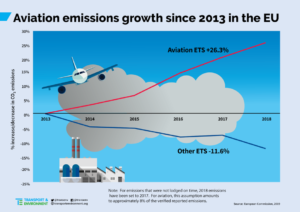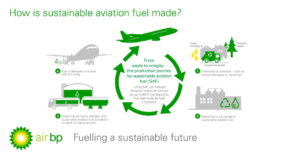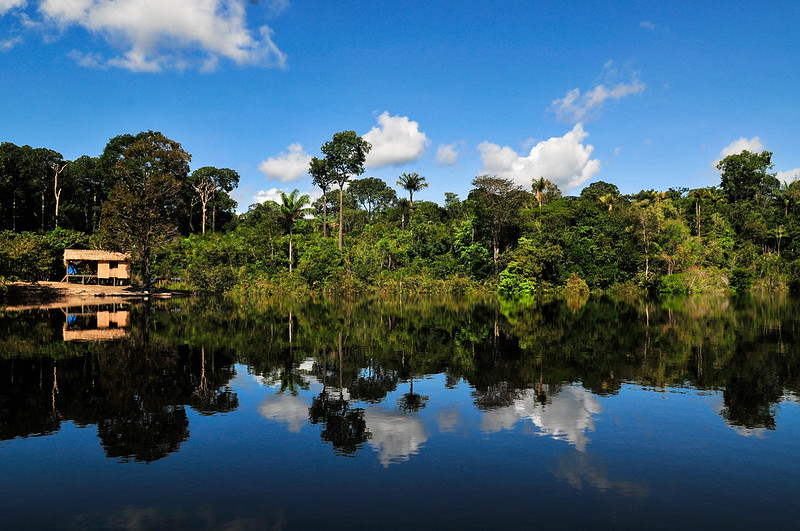Aviation has been one of the main drivers of globalisation and development of our modern world. It has generated rapid economic growth, creating millions of jobs and facilitating international trade and tourism. However, the environmental consequences of commercial aviation do not have such positive repercussions.
Nowadays, according to Boston Consulting Group, commercial aviation accounts for about 2.6% of global greenhouse gas (GHG) emissions, and projections suggest that without major intervention, that could rise to as much as 20% by 2050. The industry has set long-term decarbonization targets, including a 50% reduction in net emissions by 2050 compared with 2005 levels.
So far, progress against that goal has been limited.

The industry defends itself by arguing that, despite the disastrous consequences on the planet and its ecosystems, aviation represents less of a threat than other industry sectors, as the largest contributor to CO2 emissions remains electricity generation (44%), followed by road transport (17%), and construction (10%).
Such arguments no longer convince the public since sustainability imperatives are growing in virtually all industries. The general view is that everyone should pitch in and do their part in fighting climate change, and aviation is no exception. The alarming numbers in the aviation industry have led citizens across the world to take matters into their own hands.
According to Transport & Environment, in Sweden, a public campaign for people to fly less appears to be having a significant impact on air travel. In fact, Swedavia AB, the Swedish company which operates 10 Swedish airports, has seen year-on-year passenger numbers drop for seven months in a row. In 2018, Sweden had its weakest overall growth in passenger numbers in a decade. Meanwhile, passenger numbers at the state train operator increased to a record 32 million last year.
Rising Demand for Sustainable Travelling Puts Pressure on Commercial Aviation
A study conducted by Booking.com revealed 55% of global travelers report being more determined to make sustainable travel choices. There has never been more demand for sustainable traveling and commercial aviation is seeing a growing pressure to catch up.
As a result, a variety of new technologies and solutions are emerging to increase efficiency and reduce greenhouse gas emissions in the aeronautical domain, and government regulations are increasing the requirements for efficiency and sustainable operations.

Sustainable Aviation Fuel (SAF) is amongst the most mature breakthrough sustainable technologies for the aerospace industry. Made from renewable waste materials such as used cooking oil instead of crude oil, these waste materials contain a substantial amount of carbon, the main building block for SAF. As this is already existing carbon from our atmosphere, SAF emits no new carbon when used in neat form in an engine. The only new emissions come from production, which Neste, a leading Sustainable Aviation Fuel (SAF) producer, aims to make carbon-neutral by 2035.

According to GreenBiz, more than 40 airlines globally already have implemented SAF at this stage, with an estimated 200,000 commercial flights using SAF since 2011 and 1.6 billion gallons of SAF committed to forward purchasing agreements.
However, one of the issues facing a broader rollout of SAF is that of supply. Neste currently produces about 100,000 tonnes annually and is looking to scale up to one million tonnes by 2023 through investment into its Singapore facilities. Considering that global consumption of jet fuel prior to the pandemic was around 330 million tonnes per annum, this represents just a drop in the fossil fuel ocean.
In addition to encouraging the adoption of SAF, airframe manufacturers are also pursuing longer-term strategies aimed at achieving higher efficiencies. One such initiative is the development of higher bypass ratio engines (HBPR). As opposed to low bypass engines, HBPR sends larger volumes of air around jet turbines and thus requires less fuel.
…the absolute amount of GHG emissions will continue to rise, causing the industry to miss its 2050 targets by a gap of 800 to 1,400 million tons of CO2…
For example, the CFM International’s LEAP engine (Leading Edge Aviation Propulsion), a high-bypass turbofan produced as a 50/50 joint venture between American GE Aviation and French Safran Aircraft Engines, is designed to become the greenest HBPR in the market, aiming to reduce CO2 emissions by 15% and NOx emissions by 50% (2019 figures) comparing to the earlier LEAP engine version.
Aircraft designers are also focusing on developing aerodynamic structures such as winglets that can improve the efficiency of airflow around a wing. Historically, the most sustainable wing technology has been the introduction of passive winglets. This modification began appearing on commercial aircraft in the 1990s, and aims to improve aircraft climb and reduce drag, which reduces fuel consumption and CO2 emissions by 3% to 5%. The global implementation of passive winglets has saved over ten billion gallons of aviation fuel, a substantial impact but not nearly enough to sustain the future of the industry.
Whilst companies have demonstrated a considerable effort to implement sustainable measures, such as developing sustainable aviation fuel (SAF), the gains from these measures are likely to be overtaken by steady growth in air traffic of 1% to 4% through 2050. That means the absolute amount of GHG emissions will continue to rise, causing the industry to miss its 2050 targets by a gap of 800 to 1,400 million tons of CO2.
Related Articles: Chanel: Iconic in Luxury, Standard in Sustainability | Diamonds and Degradation: Luxury’s Sustainability Struggle
True sustainability requires industry actors to foster a vision encompassing more than the development of aerodynamic structures and Sustainable Aviation Fuels. By encouraging collaboration and coordination amongst stakeholders, companies could help each other identify new opportunities in adjacent business areas, such as hydrogen value chain, battery manufacturing, or airport building infrastructure.
Such collaboration would allow organizations to expand to other industries and develop products that address broader decarbonization challenges. A truly sustainable future can only be built upon a foundation of inter-industry cooperation and a shared vision to mitigate climate change.
CSR Performance of Commercial Aviation: How the Impakter Index can Help Promote Sustainable Travel
Commercial aviation will remain in the foreseeable future under consumer pressure to perform more sustainably. And that pressure is a powerful incentive for companies to seek the above-mentioned opportunities to achieve greater sustainability. And here is where the Impakter Sustainability Index comes into play. It helps travelers identify which are the airlines that are well-governed and fly responsibly.
The Impakter Index makes such comparisons possible by providing sustainability ratings based on extensive analysis and reports on the companies’ Corporate Social Responsibility performance. So far, the Top 100 Employers have been rated by the Impakter Index and they include some of the largest commercial airlines such as Delta and American Airlines. Remarkably, and this may come as a surprise, both companies have been assigned a C rating – which means that they are “mediocre” on the sustainability front. In other words, their business model is not sustainable and they will need to implement a broad range of measures to become sustainable.
In short, the Impakter Index was designed to help travelers make eco-conscious choices because the ratings it provides are the most trustworthy available in the industry.
Why? Because its ratings are built on mega evaluation techniques that pull together analyses of specific data such as greenhouse gas emission reduction targets and progress made towards those targets. The ratings are also expressed in a single easy-to-understand letter (A, B, C, D, F) that reflects the various ratings companies have obtained from industry certification systems, showing their degree of compliance with the UN Sustainable Development Goals. With data provided by the Impakter Index, travelers can push harder than ever for the rise of sustainable travel.
Editor’s Note: The opinions expressed here by Impakter.com columnists or contributors are their own, not those of Impakter.com. — In the Featured Photo: Aeroplane wing within the clouds. Featured Photo Credit: Ross Parmly on Unsplash










